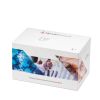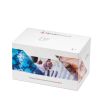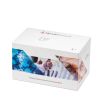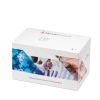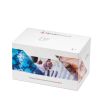LBP, Human, ELISA kit – 2 x 96 det. - HK315-02
Quantity
2 x 96 det.
Catalog #
HK315-02
1.153,00 €
Lipopolysacharide (LPS) Binding Protein (LBP) is a type 1 acute phase protein that is constitutively produced by the liver and rapidly upregulated during the acute phase response.
LBP plays a central role in the response to LPS. The protein catalyzes the monomerization of LPS and its transfer to (s)CD14 and to lipoproteins. This way LBP has both a role in the activation pathway of LPS: activation of monocytes by LPS leading to release of inflammatory mediators and in the neutralization of LPS i.e. the uptake of LPS by lipoprotein and subsequent clearing. In plasma of healthy individuals LBP is present at levels of approximately 10 µg/ml, which increase approximately 10-fold during acute phase responses.
| Datasheet URL | https://www.hycultbiotech.com/wp-content/uploads/2022/06/HK315-1016.pdf |
|---|---|
| Quantity | 2 x 96 det. |
| Quantity | 2 x 96 det. |
| Standard range | 4.4-50 ng/ml |
| Detection level | 4.4 ng/ml |
| Working volume | 100 µl/well |
| Species | human |
| Application | The human LBP ELISA kit is to be used for the in vitro quantitative determination of human LBP in serum, plasma and cell culture supernatant samples. |
| Principle | The human LBP ELISA is a ready-to-use solid-phase enzyme-linked immunosorbent assay based on the sandwich principle with a working time of 3½ hours. The efficient format of a plate with twelve disposable 8-well strips allows free choice of batch size for the assay. Samples and standards are captured by a solid bound specific antibody. Biotinylated tracer antibody will bind to captured human LBP. Streptavidin-peroxidase conjugate will bind to the biotinylated tracer antibody. Streptavidin-peroxidase conjugate will react with the substrate, tetramethylbenzidine (TMB). The enzyme reaction is stopped by the addition of oxalix acid. The absorbance at 450 nm is measured with a spectrophotometer. A standard curve is obtained by plotting the absorbance (linear) versus the corresponding concentrations of the human LBP standards (log). The human LBP concentration of samples, which are run concurrently with the standards, can be determined from the standard curve. |
| Storage and stability | Product should be stored at 4 °C. Under recommended storage conditions, product is stable for at least six months. |
| Precautions | For research use only. Not for use in or on humans or animals or for diagnostics. It is the responsibility of the user to comply with all local/state and Federal rules in the use of this product. Hycult Biotech is not responsible for any patent infringements that might result with the use of or derivation of this product. |
| References | 1. Labéta, M et al; Innate recognition of bacteria in human milk is mediated by a milkderived
highly expressed pattern recognition receptor, soluble CD14. J Exp Med 2000,
191: 1807 2. Ahrén, I et al; Lipopolysaccharide-binding protein increases toll-like receptor 4- dependent activation by nontypeable Haemophilus influenzae. J Infect Dis 2001, 184 : 926 3. Kaser, A et al; Endotoxin and its binding proteins in chronic liver disease: the effect of transjugular intrahepatic portosystemic shunting. Liver 2002, 22: 380 4. Blais, D et al; LBP and CD14 secreted in tears by the lacrimal glands modulate the LPS response of corneal epithelial cells. Invest Ophthalmol Vis Sci 2005, 46: 4235 5. Poikonen, K et al; Susceptibility of human monocyte-macrophages to Chlamydia pneumoniae Infection in vitro is highly variable and associated with levels of soluble CD14 and C. pneumoniae IgA and human HSP-IgG antibodies in serum. Scand J Immunol 2008, 67: 279 6. Lepper, P et al; Association of Lipopolysaccharide-Binding Protein and Coronary Artery Disease in Men. JACC 2007, 50: 25 7. Redd, A et al; Microbial translocation, the innate cytokine response, and HIV-1 disease progression in Africa. PNAS 2009, 106: 6718 8. Clark, R et al; Assessment of cholesteryl ester transfer protein inhibitors for interaction with proteins involved in the immune response to infection. Journal of Lipid Research 2012, 51: 967 9. Tsukamoto, H et al; Lipopolysaccharide-binding protein-mediated Toll-like receptor 4 dimerization enables rapid signal transduction against lipopolysaccharide stimulation on membrane-associated CD14-expressing cells. Int Immunol 2010, 22: 271 10. Garate, I et al; Origin and consequences of brain Toll-like receptor 4 pathway stimulation in an experimental model of depression. J of Neuroinflam 2011, 8: 151 11. Ngan, D et al; The relationship of systemic inflammation to prior hospitalization in adult patients with cystic fibrosis. BMC Pulm Med 2012, 12: 3 |
| Disease | Infectious diseases |
| Application assays: | The human LBP ELISA kit is to be used for the in vitro quantitative determination of human LBP in serum, plasma and cell culture supernatant samples. |
|---|---|
| Principle: | The human LBP ELISA is a ready-to-use solid-phase enzyme-linked immunosorbent assay based on the sandwich principle with a working time of 3½ hours. The efficient format of a plate with twelve disposable 8-well strips allows free choice of batch size for the assay. Samples and standards are captured by a solid bound specific antibody. Biotinylated tracer antibody will bind to captured human LBP. Streptavidin-peroxidase conjugate will bind to the biotinylated tracer antibody. Streptavidin-peroxidase conjugate will react with the substrate, tetramethylbenzidine (TMB). The enzyme reaction is stopped by the addition of oxalix acid. The absorbance at 450 nm is measured with a spectrophotometer. A standard curve is obtained by plotting the absorbance (linear) versus the corresponding concentrations of the human LBP standards (log). The human LBP concentration of samples, which are run concurrently with the standards, can be determined from the standard curve. |



